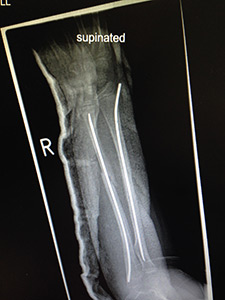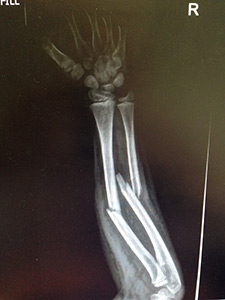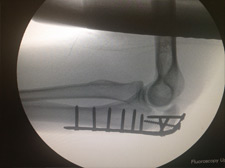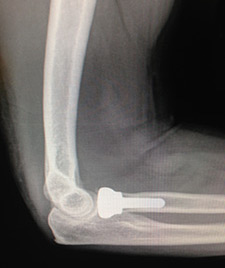Fractures & Trauma
A bone fracture is a medical condition in which a bone is cracked or broken. It is a break in the continuity of the bone.
A bone may get fractured completely or partially and it is caused commonly from trauma due to fall, motor vehicle accident or sports. Thinning of the bone due to osteoporosis in the elderly can cause the bone to break easily. Overuse injuries are common cause of stress fractures in athletes.
Types of fractures include:
- Simple fractures in which the fractured pieces of bone are well aligned and stable.
- Unstable fractures are those in which fragments of the broken bone are misaligned and displaced.
- Open (compound) fractures are severe fractures in which the broken bones cut through the skin. This type of fracture is more prone to infection and requires immediate medical attention.
- Greenstick fractures: This is a unique fracture in children that involves bending of one side of the bone without any break in the bone.
Fracture Healing
Our body reacts to a fracture by protecting the injured area with a blood clot and callus or fibrous tissue. Bone cells begin forming on the either side of the fracture line. These cells grow towards each other and thus close the fracture.
Medical Therapy
The objective of early fracture management is to control bleeding, prevent ischemic injury (bone death) and to remove sources of infection such as foreign bodies and dead tissues. The next step in fracture management is the reduction of the fracture and its maintenance. It is important to ensure that the involved part of the body returns to its function after fracture heals. To achieve this, maintenance of fracture reduction with immobilization technique is done by either non-operative or surgical method.
Non-operative (closed) therapy comprises of casting and traction (skin and skeletal traction).
- Casting
closed reduction is done for any fracture that is displaced, shortened, or angulated. Splints and casts made up of fiberglass or plaster of Paris material are used to immobilize the limb. - Traction
Traction method is used for the management of fractures and dislocations that cannot be treated by casting. There are two methods of traction namely, skin traction and skeletal traction.
Skin traction involves attachment of traction tapes to the skin of the limb segment below the fracture. In skeletal traction, a pin is inserted through the bone distal to the fracture. Weights will be applied to this pin, and the patient is placed in an apparatus that facilitates traction. This method is most commonly used for fractures of the thighbone.
Surgical Therapy
- Open Reduction and Internal Fixation (ORIF)
This is a surgical procedure in which the fracture site is adequately exposed and reduction of fracture is done. Internal fixation is done with devices such as Kirschner wires, plates and screws, and intramedullary nails. - External fixation
External fixation is a procedure in which the fracture stabilization is done at a distance from the site of fracture. It helps to maintain bone length and alignment without casting.
External fixation is performed in the following conditions:
- Open fractures with soft-tissue involvement
- Burns and soft tissue injuries
- Pelvic fractures
- Comminuted and unstable fractures
- Fractures having bony deficits
- Limb-lengthening procedures
- Fractures with infection or non-union
Rehabilitation
Fractures may take several weeks to months to heal completely. You should limit your activities even after the removal of cast or brace so that the bone become solid enough to bear the stress. Rehabilitation program involves exercises and gradual increase in activity levels until the process of healing is complete.
Arm, Elbow
Broken Arm
The forearm is made up of 2 bones namely the radius and ulna. The primary function of your forearm is rotation i.e., the ability to turn your palms up and down. The fracture of the forearm affects the ability to rotate your arm, as well as bend and straighten the wrist and elbow. The breaking of the radius or ulna in the middle of the bone requires a strong force and it is most commonly seen in adults. In most of the cases, both bones are broken during a forearm fracture.
The forearm bones can break in several ways. The bones can crack slightly or can break into many pieces. Forearm fractures are generally due to automobile accidents; direct blow on the forearm or fall on an outstretched arm during sports, climbing stairs, etc.


Symptoms
The symptoms of a forearm fracture include intense pain in the arm, bruises and swelling. Your fractured forearm may appear bent and shorter compared to your other arm. You may experience numbness or weakness in the fingers and wrist. You may be unable to rotate your arm. Rarely, a broken bone sticks out through the skin or the wound penetrates down to the broken bone.
Diagnosis
Your doctor may conduct a physical examination and record your medical history initially. Your doctor may feel your arm thoroughly to determine tenderness. You may be asked to get an X-ray done to determine displaced or broken bones.
Treatment
Usually people with forearm fractures are immediately rushed to the emergency room for treatment. Treatment of forearm fracture aims at putting back the broken bones into position and preventing them from moving out of place until they are completely healed.
Nonsurgical Treatment
In case only one bone is broken and is not out of place, your doctor might treat it with a cast or brace and provide a sling to keep your arm in position. Your doctor will closely monitor the healing of the fracture. If the fracture shifts in position, you may be advised to undergo surgery to fix the bones back together.
Surgical Treatment
When both forearm bones are broken, surgery is usually required. During surgery, the cuts from the injury will be cleaned and the bone fragments are repositioned into their normal alignment. They are held together with screws and metal plates attached to the outer surface of the bone. The incision is sutured firmly and a sling is provided to facilitate healing.
Distal Humerus Fractures of the Elbow
The elbow is a region between the upper arm and the fore arm. The elbow joint is made up of 3 bones. The distal (lower) end of the humerus bone in the upper arm joins with the radius and ulna bones in the fore arm to form the elbow joint. The elbow joint is very important for the movement of your arms and for coordination of daily activities. Injury in the distal humerus can cause impairment in the function of the elbow joint. Distal humerus fracture is a rare condition which occurs when there is break in the lower end of the humerus. The treatment of distal humerus fracture aims at restoration of normal anatomy.
Causes
A distal humerus fracture may result due to a fall. This occurs more often when you land directly on your elbow during the fall or when you get struck by a hard object. It can also happen when you fall on your outstretched arm with the elbow locked straight.
Symptoms
Distal humerus fractures are usually very painful. The common symptoms are swelling, bruising, stiffness, tenderness, severe pain and inability to move the arm.
Diagnosis
Distal humerus fractures are generally considered an emergency condition. Your doctor might examine the skin to check for any cuts and feel it to determine the presence of broken bones or injuries. Your doctor might recommend an X-ray examination to determine the depth (intact or broken bones) of the fracture.
Treatment
Distal humerus fractures can be treated by both non-surgical and surgical methods based on the intensity of the fracture.
Non-surgical Treatment
If the fracture has not caused displacement of the bone, then your doctor might apply a splint (a casting) and you may be required to wear a sling until complete healing and recovery occurs.
Surgical Treatment
Your doctor might recommend surgery if the fracture has led to the displacement of bone and pieces of the bone have exited the skin. During surgery, the displaced bone or pieces of bone are joined together with the help of metal screws and plates. You may also be given antibiotics to avoid the risk of infection.
Prevention
Care should be taken while you walk or run and especially while climbing up/down the stairs. This can prevent you from falling and eventually from accidental fractures.
Adult Forearm Fractures
The forearm is made up of 2 bones namely the radius and ulna. The primary function of your forearm is rotation i.e., the ability to turn your palms up and down. The fracture of the forearm affects the ability to rotate your arm, as well as bend and straighten the wrist and elbow. The breaking of the radius or ulna in the middle of the bone requires a strong force and it is most commonly seen in adults. In most of the cases, both bones are broken during a forearm fracture.
Cause
The forearm bones can break in several ways. The bones can crack slightly or can break into many pieces. Forearm fractures are generally due to automobile accidents; direct blow on the forearm or fall on an outstretched arm during sports, climbing stairs, etc.
Symptoms
The symptoms of a forearm fracture include intense pain in the arm, bruises and swelling. Your fractured forearm may appear bent and shorter compared to your other arm. You may experience numbness or weakness in the fingers and wrist. You may be unable to rotate your arm. Rarely, a broken bone sticks out through the skin or the wound penetrates down to the broken bone.
Diagnosis
Your doctor may conduct a physical examination and record your medical history initially. Your doctor may feel your arm thoroughly to determine tenderness. You may be asked to get an X-ray done to determine displaced or broken bones.
Treatment
Usually people with forearm fractures are immediately rushed to the emergency room for treatment. Treatment of forearm fracture aims at putting back the broken bones into position and preventing them from moving out of place until they are completely healed.
Nonsurgical Treatment
In case only one bone is broken and is not out of place, your doctor might treat it with a cast or brace and provide a sling to keep your arm in position. Your doctor will closely monitor the healing of the fracture. If the fracture shifts in position, you may be advised to undergo surgery to fix the bones back together.
Surgical Treatment
When both forearm bones are broken, surgery is usually required. During surgery, the cuts from the injury will be cleaned and the bone fragments are repositioned into their normal alignment. They are held together with screws and metal plates attached to the outer surface of the bone. The incision is sutured firmly and a sling is provided to facilitate healing.
Olecranon (Elbow) Fractures

Three bones, humerus, radius and ulna make up the elbow joint. The bones are held together by ligaments thus providing stability to the joint. Muscles and tendons around the bones coordinate the movements and help in performing various activities. Elbow fractures may occur from trauma resulting from a variety of reasons, some of them being a fall on an outstretched arm, a direct blow to the elbow, or an abnormal twist to the joint beyond its functional limit.
Olecranon fractures: These are fractures occurring at bony prominence of the ulna. The fractures, if stable, are treated using an immobilizing splint followed by a regimen of motion exercises. However severe fractures require surgical repair.
Symptoms of an olecranon fracture include pain, swelling, bruising, stiffness in and around the elbow, a popping or cracking sound, and deformity of the elbow bones.
To diagnose olecranon fractures X-rays of the joint are taken. In some cases, a CT scan may be needed to get to know the details of the joint surface.
The aim of the treatment is to maximize early motion to reduce the risk of stiffness. Nonsurgical treatment options include use of a splint or a sling to immobilize the elbow during the healing process. Surgery is indicated in displaced and open fractures to realign the bones and stabilize the joint as well as to avoid deep infections.
Strengthening exercises, scar massage, therapy with ultrasound, heat, and ice are recommended to improve the range of motion. Splints are also used to facilitate stretching of the joint.
Radial Head Fractures

The elbow is a junction between the forearm and the upper arm. The elbow joint is made up of 3 bones namely the humerus bone in the upper arm which joins with the radius and ulna bones in the forearm. The elbow joint is essential for the movement of your arms and to perform daily activities. The head of the radius bone is cup-shaped and corresponds to the spherical surface of the humerus. The injury in the head of the radius causes impairment in the function of the elbow. Radial head fractures are very common and occur in almost 20% of acute elbow injuries. Elbow dislocations are generally associated with radial head fractures. Radial head fractures are more common in women than in men and occur more frequently in the age group of 30 and 40 years.
The most common cause of a radius head fracture is breaking a fall with an outstretched arm. Radial head fractures can also occur due to a direct impact on the elbow, a twisting injury, sprain, dislocation or strain.
The symptoms of a radial head fracture include severe pain, swelling in the elbow, difficulty in moving the arm, visible deformity indicating dislocation, bruising and stiffness.
Your doctor might recommend an X-ray to confirm the fracture and assess displacement of the bone. Sometimes, your doctor might suggest a CT scan to obtain further details of the fracture, especially the joint surfaces.
The treatment of a fracture depends on the type of fracture.
- Type 1 fractures are usually very small. The bone appears cracked, but remains fitted together. The doctor might use a splint (casting) to fix the bone and you might have to wear a sling for a few days. If the crack becomes intense or the fracture gets deep, then your doctor might suggest surgical treatment.
- Type 2 fractures are characterized by displacement of bones and breaking of bones in large pieces and can be treated by surgery. During surgery, your doctor will correct the soft-tissue injuries and insert screws and plates to hold the displaced bone together firmly. Small pieces of bone may be removed if it prevents normal movement of the elbow.
- Type 3 fractures are characterized by multiple broken pieces of bone. Surgery is considered the compulsory treatment to either fix or to remove the broken pieces of bone, sometimes including the radial head. An artificial radius head may be placed to improve the function of the elbow.









